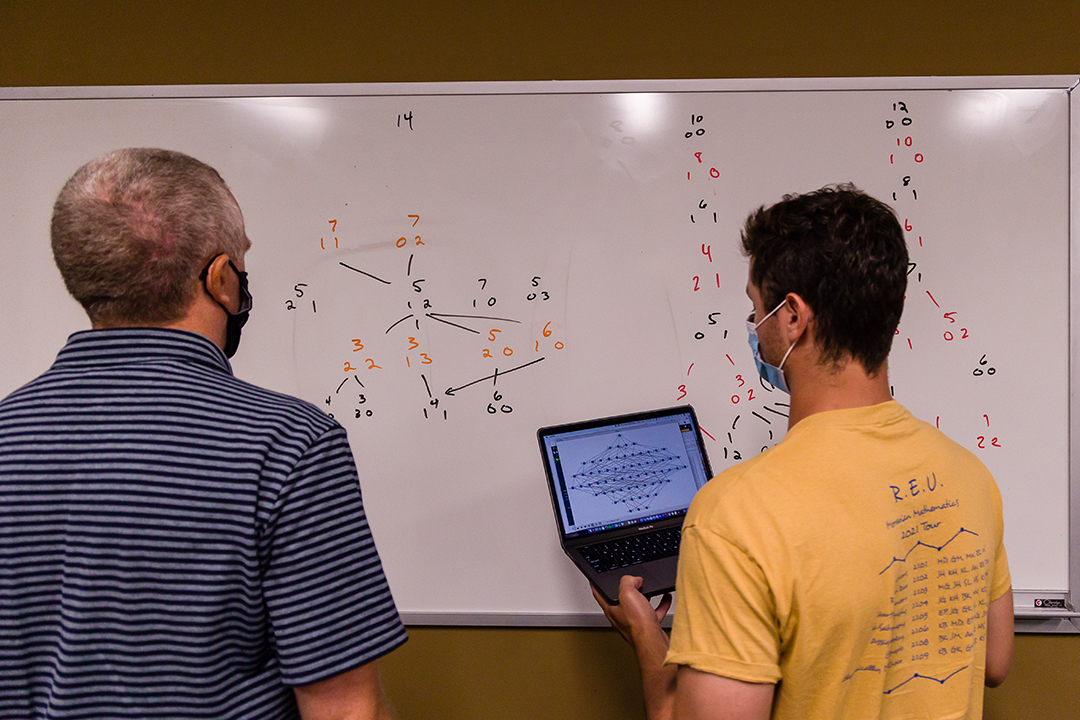Garrison Koch ’23
2021 SOAR Profile
On the Girth of Assignment Graphs Generated from Digraphs
and
On the Solvability of a Bipartite Graph Reduction Game
Major: Applied Mathematics
Hometown: New York, NY
Project Advisor(s): Dr. Nathan Shank
Briefly describe your project.
I worked in two project groups. In the first group, we looked at Assignment Graphs which are generated from a mathematical concept called Graph Pebbling. The Assignment Graph of a pebbling assignment is all the possible pebbling moves that can be made. We looked at properties of these assignment graphs like when they generate certain size cycles (girths) and when they are isomorphic to their pebbling assignment. In the second group we looked at a bipartite graph game where you decrease labels of adjacent vertices until all labels are at zero (you have won) or there are no more moves left to be made but some vertices still have a label (you have lost). We looked at what properties yielded winning or losing graphs.

Garrison Koch ’23
Describe the origin of your project. (E.g., did you pitch the idea and choose a faculty member, or did they come to you with an idea?)
The two projects I worked on were ones I picked out of a list of nine projects. Those nine projects were dispersed throughout the cohort, each student being a part of two of them. Although the topics were preselected, they were merely a leap off—a starting point. The direction we took the problem was in the hands of the students.
What’s the best part about working with your faculty mentor? What valuable insights have they brought to your project?
Dr. Shank was incredibly helpful in guiding me but also allowing me the space to struggle and delve into the problem independently. The majority of the problem was not known, so there is no research that could be done. However, having an extended background in math allowed Dr. Shank to pull in other mathematical concepts that would point me in the right direction to figure out a piece of the problem.
What has been your biggest obstacle so far?
A difficult part of both projects was that once we found a direction to go in, and found some preliminary results, we hit a point where the results hit a halt. At this point, we had to make a decision on what would be the best use of our time, and make for the most interesting results. When the problem had just begun, results were coming quicker so we did not have to be picky. However, making the decision to look at something specific, and more importantly, the decision to not look at certain things due to time was the most difficult.
What has been your biggest takeaway from this experience?
I had many amazing takeaways from this experience. The biggest of them is definitely the confidence to pursue a career in mathematics and having an experience that showed me what that may look like. It is one thing to take classes, but being able to apply what I have learned showed me that a career path in math is possible and something I would enjoy. I was also exposed to quality resources and interacted with graduate students. This allowed me to come away from the experience with a lot more knowledge about what graduate school in mathematics would look like.
What was the result of your project?
In both of my groups, we made substantial progress on our unanswered questions. For the Bipartite Graph game group, we have made many conclusions about which conditions yield solvability on which boards, and are still meeting weekly to finish our paper on it. For the Assignment Graph group, we have made conclusions about a number of related topics and have been presenting these results in a few conferences. I continue to work with Dr. Shank and a few new students and faculty every week on the problem.
In your own words, how do you feel about being awarded this opportunity? Why should other students take advantage of the SOAR program at Moravian University?
I was very honored to be awarded the SOAR opportunity this summer. Naturally, as excited as I was about participating I worried it would just feel like more school. Much to my delight, it did not feel at all like “more school,” as the type of work and thinking we were doing is very different and a lot more enticing than classroom problems and exams. I would recommend the experience to any student for this very reason. It was very special to be able to learn and continue my knowledge in math as much, if not more than in the classroom, but do so in an environment and dynamic I enjoyed.
Now that SOAR is over, do you plan to expand upon your research? If so, how?
Yes, very much so. As mentioned in above questions, I am continuing to meet with Dr. Shank weekly to continue working on our problem. Although we have finished our discoveries for the moment in my other group, we are continuing to meet to finalize the paper.
Have you, or do you plan to present this research outside the SOAR presentations? If so, where? Be specific, if possible.
Yes, we have been very lucky to have multiple opportunities to present our findings. We have already presented at the Northeastern Combinatorics Klatch and the Young Mathematicians conference. We have also applied to present at the Joint Mathematics Meetings which are in Seattle in January. That would be the first in-person conference, which is very exciting as we await our acceptance.
